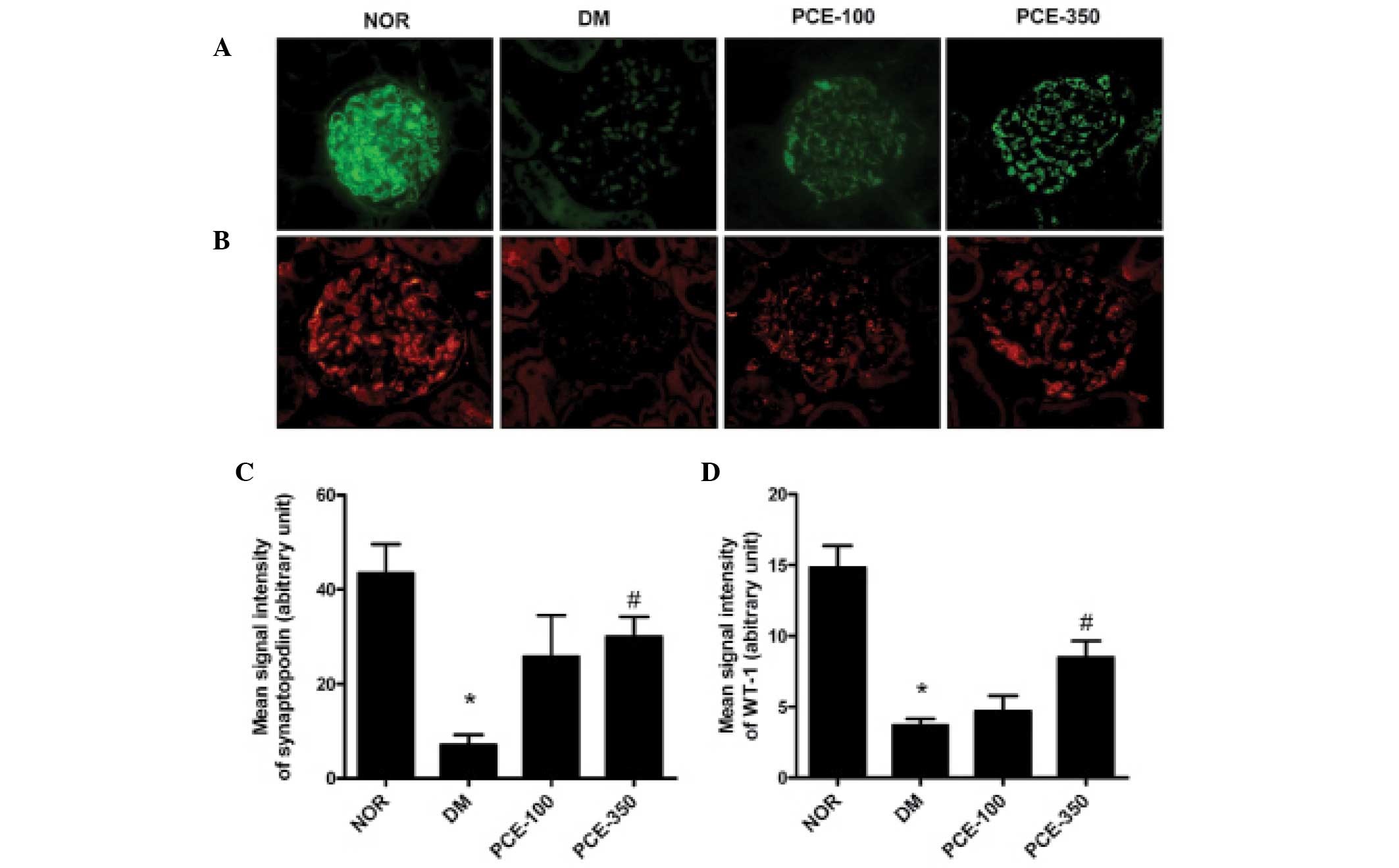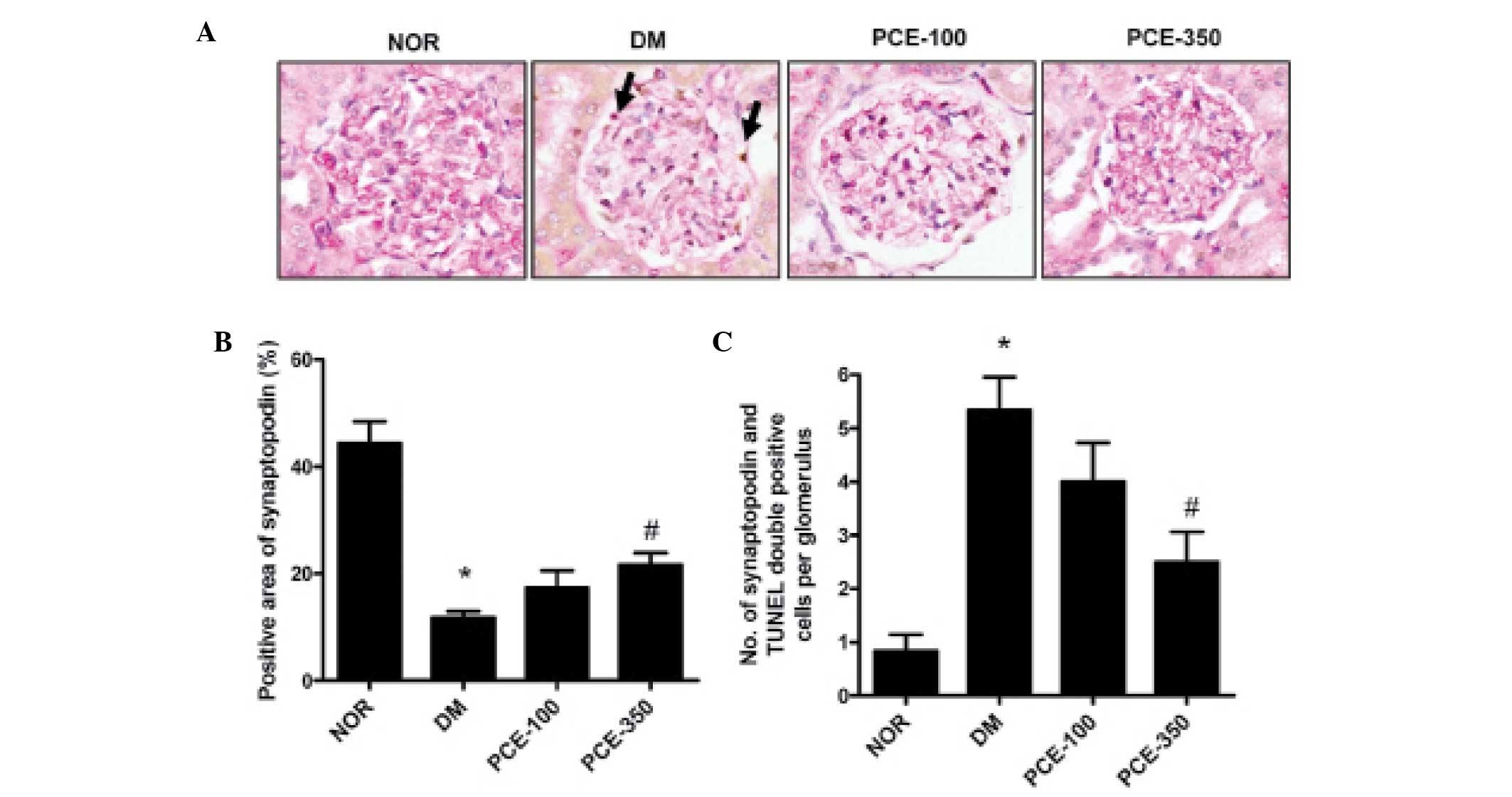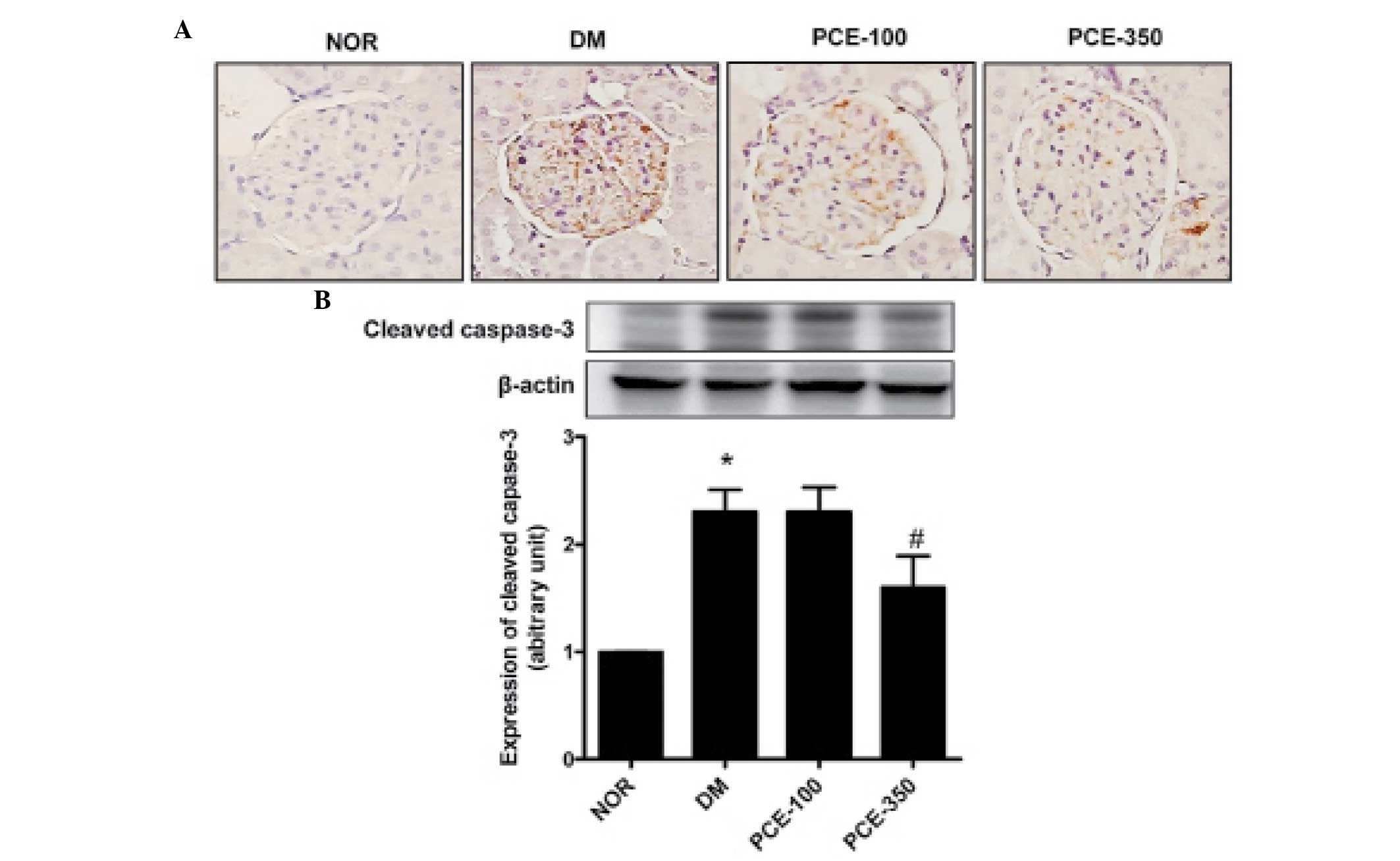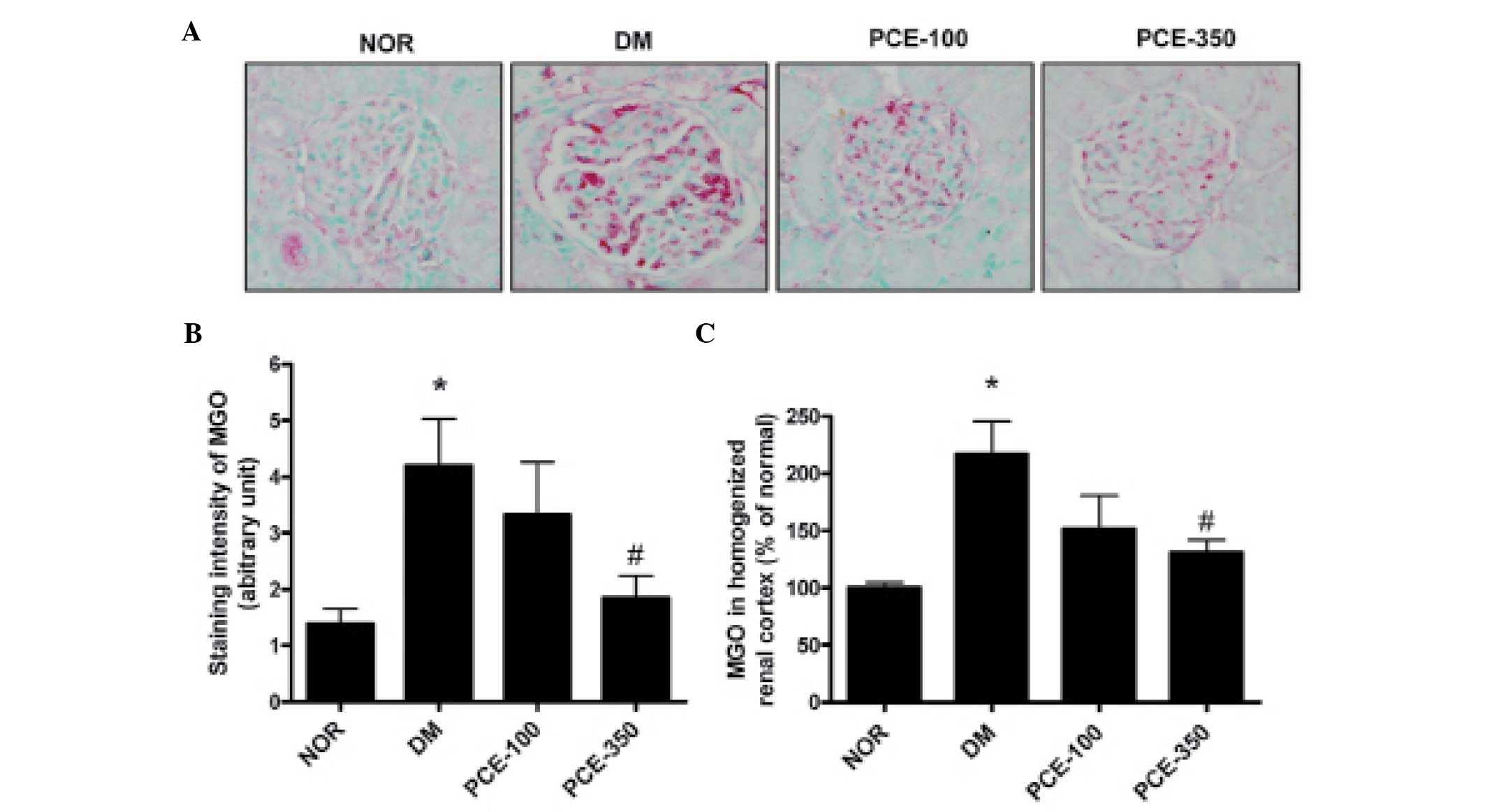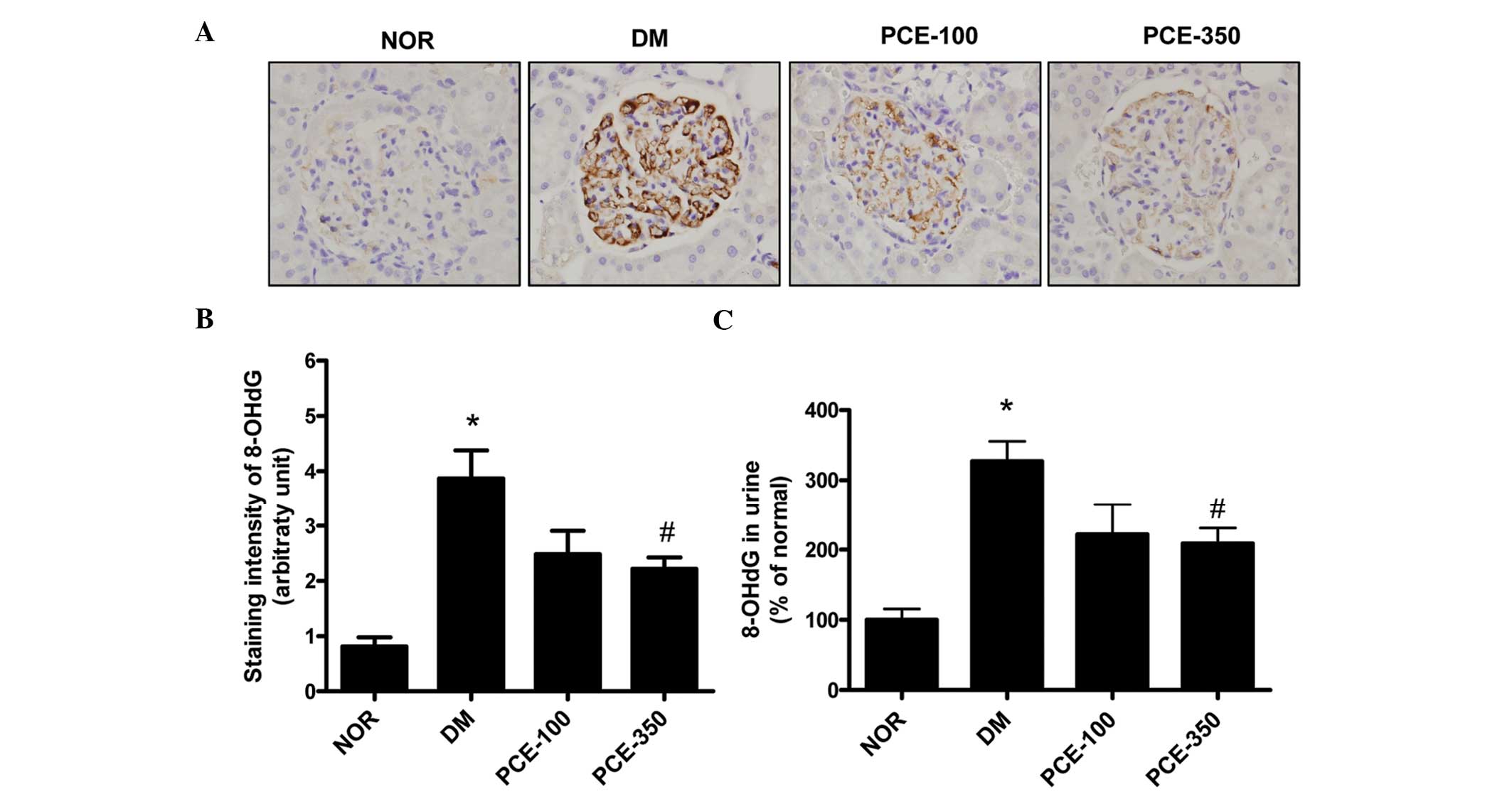|
1
|
White KE and Bilous RW: Type 2 diabetic
patients with nephropathy show structural-functional relationships
that are similar to type 1 disease. J Am Soc Nephrol. 11:1667–1673.
2000.PubMed/NCBI
|
|
2
|
Steffes MW, Schmidt D, McCrery R and
Basgen JM; International Diabetic Nephropathy Study Group:
Glomerular cell number in normal subjects and in type 1 diabetic
patients. Kidney Int. 59:2104–2113. 2001. View Article : Google Scholar : PubMed/NCBI
|
|
3
|
Susztak K, Raff AC, Schiffer M and
Böttinger EP: Glucose-induced reactive oxygen species cause
apoptosis of podocytes and podocyte depletion at the onset of
diabetic nephropathy. Diabetes. 55:225–233. 2006. View Article : Google Scholar
|
|
4
|
Gui D, Guo Y, Wang F, Liu W, Chen J, Chen
Y, Huang J and Wang N: Astragaloside IV, a novel antioxidant,
prevents glucose-induced podocyte apoptosis in vitro and in vivo.
PloS one. 7:e398242012. View Article : Google Scholar : PubMed/NCBI
|
|
5
|
Zhang Y, Chen B, Hou XH, Guan GJ, Liu G,
Liu HY and Li XG: Effects of mycophenolate mofetil, valsartan and
their combined therapy on preventing podocyte loss in early stage
of diabetic nephropathy in rats. Chin med J. 120:988–995.
2007.PubMed/NCBI
|
|
6
|
Estacio RO and Schrier RW: Diabetic
nephropathy: Pathogenesis, diagnosis and prevention of progression.
Adv Intern Med. 46:359–408. 2001.
|
|
7
|
Ha H, Kim C, Son Y, Chung MH and Kim KH:
DNA damage in the kidneys of diabetic rats exhibiting
microalbuminuria. Free Radic Biol Med. 16:271–274. 1994. View Article : Google Scholar : PubMed/NCBI
|
|
8
|
Kakimoto M, Inoguchi T, Sonta T, Yu HY,
Imamura M, Etoh T, Hashimoto T and Nawata H: Accumulation of
8-hydroxy-2′-deoxyguanosine and mitochondrial DNA deletion in
kidney of diabetic rats. Diabetes. 51:1588–1595. 2002. View Article : Google Scholar : PubMed/NCBI
|
|
9
|
Marshall CB, Pippin JW, Krofft RD and
Shankland SJ: Puromycin aminonucleoside induces oxidant-dependent
DNA damage in podocytes in vitro and in vivo. Kidney Int.
70:1962–1973. 2006.PubMed/NCBI
|
|
10
|
Yamada H, Miyata S, Igaki N, Yatabe H,
Miyauchi Y, Ohara T, Sakai M, Shoda H, Oimomi M and Kasuga M:
Increase in 3-deoxyglucosone levels in diabetic rat plasma.
Specific in vivo determination of intermediate in advanced Maillard
reaction. J Biol Chem. 269:20275–20280. 1994.PubMed/NCBI
|
|
11
|
McLellan AC, Thornalley PJ, Benn J and
Sonksen PH: Glyoxalase system in clinical diabetes mellitus and
correlation with diabetic complications. Clin Sci (Lond). 87:21–29.
1994. View Article : Google Scholar
|
|
12
|
Lapolla A, Flamini R, Dalla Vedova A,
Senesi A, Reitano R, Fedele D, Basso E, Seraglia R and Traldi P:
Glyoxal and methylglyoxal levels in diabetic patients: Quantitative
determination by a new GC/MS method. Clin Chem Lab Med.
41:1166–1173. 2003. View Article : Google Scholar : PubMed/NCBI
|
|
13
|
Randell EW, Vasdev S and Gill V:
Measurement of methylg-lyoxal in rat tissues by electrospray
ionization mass spectrometry and liquid chromatography. J Pharmacol
Toxicol Methods. 51:153–157. 2005. View Article : Google Scholar : PubMed/NCBI
|
|
14
|
Amicarelli F, Colafarina S, Cattani F,
Cimini A, Di Ilio C, Ceru MP and Miranda M: Scavenging system
efficiency is crucial for cell resistance to ROS-mediated
methylglyoxal injury. Free Radic Biol Med. 35:856–871. 2003.
View Article : Google Scholar : PubMed/NCBI
|
|
15
|
Pedchenko VK, Chetyrkin SV, Chuang P, Ham
AJ, Saleem MA, Mathieson PW, Hudson BG and Voziyan PA: Mechanism of
perturbation of integrin-mediated cell-matrix interactions by
reactive carbonyl compounds and its implication for pathogenesis of
diabetic nephropathy. Diabetes. 54:2952–2960. 2005. View Article : Google Scholar : PubMed/NCBI
|
|
16
|
Kim J, Sohn E, Kim CS and Kim JS: Renal
podocyte apoptosis in Zucker diabetic fatty rats: Involvement of
methylglyoxal-induced oxidative DNA damage. J Comp Pathol.
144:41–47. 2011. View Article : Google Scholar
|
|
17
|
Alarcon-Aguilara FJ, Roman-Ramos R,
Perez-Gutierrez S, Aguilar-Contreras A, Contreras-Weber CC and
Flores-Saenz JL: Study of the anti-hyperglycemic effect of plants
used as antidiabetics. J Ethnopharmacol. 61:101–110. 1998.
View Article : Google Scholar : PubMed/NCBI
|
|
18
|
Li WL, Zheng HC, Bukuru J and De Kimpe N:
Natural medicines used in the traditional Chinese medical system
for therapy of diabetes mellitus. J Ethnopharmacol. 92:1–21. 2004.
View Article : Google Scholar : PubMed/NCBI
|
|
19
|
Ban SH, Kwon YR, Pandit S, Lee YS, Yi HK
and Jeon JG: Effects of a bio-assay guided fraction from Polygonum
cuspidatum root on the viability, acid production and
glucosyltranferase of mutans streptococci. Fitoterapia. 81:30–34.
2010. View Article : Google Scholar
|
|
20
|
Bralley EE, Greenspan P, Hargrove JL,
Wicker L and Hartle DK: Topical anti-inflammatory activity of
Polygonum cuspidatum extract in the TPA model of mouse ear
inflammation. J Inflamm (Lond). 5:12008. View Article : Google Scholar
|
|
21
|
Zhang H, Li C, Kwok ST, Zhang QW and Chan
SW: A review of the pharmacological effects of the dried root of
(hu zhang) and its constituents. Evid Based Complement Alternat
Med. 2013(208349)2013.
|
|
22
|
National Research Council: Guide for the
Care and Use of Laboratory Animals. 8th edition. The National
Academies Press; Washington, DC, USA: 2011
|
|
23
|
Mundel P, Reiser J and Kriz W: Induction
of differentiation in cultured rat and human podocytes. J Am Soc
Nephrol. 8:697–705. 1997.PubMed/NCBI
|
|
24
|
Schiffer M, Mundel P, Shaw AS and
Böttinger EP: A novel role for the adaptor molecule CD2-associated
protein in transforming growth factor-beta-induced apoptosis. J
Biol Chem. 279:37004–37012. 2004. View Article : Google Scholar : PubMed/NCBI
|
|
25
|
Tang D, Zhu JX, Wu AG, Xu YH, Duan TT,
Zheng ZG, Wang RS, Li D and Zhu Q: Pre-column incubation followed
by fast liquid chromatography analysis for rapid screening of
natural methylglyoxal scavengers directly from herbal medicines:
Case study of Polygonum cuspidatum. J chromatogr A. 1286:102–110.
2013. View Article : Google Scholar : PubMed/NCBI
|
|
26
|
Shaheen F, Shmygol A, Rabbani N and
Thornalley PJ: A fluorogenic assay for methylglyoxal. Bioche Soc
Trans. 42:548–555. 2014. View Article : Google Scholar
|
|
27
|
Pan M and Wang X: Chemical constituents
and pharmacological action of Polygonum cuspidatum Sieb. Et Zucc
Zhong Yao Cai. 23:56–58. 2000.
|
|
28
|
Qian G, Leung SY, Lu G and Leung KS:
Differentiation of rhizoma et radix polygoni cuspidati from closely
related herbs by HPLC fingerprinting. Chem Pharm Bull (Tokyo).
54:1179–1186. 2006. View Article : Google Scholar
|
|
29
|
Siu B, Saha J, Smoyer WE, Sullivan KA and
Brosius FC III: Reduction in podocyte density as a pathologic
feature in early diabetic nephropathy in rodents: Prevention by
lipoic acid treatment. BMC nephrol. 7:62006. View Article : Google Scholar : PubMed/NCBI
|
|
30
|
Riedl E, Pfister F, Braunagel M,
Brinkkötter P, Sternik P, Deinzer M, Bakker SJ, Henning RH, van den
Born J, Krämer BK, et al: Carnosine prevents apoptosis of
glomerular cells and podocyte loss in STZ diabetic rats. Cell
Physiol Biochem. 28:279–288. 2011. View Article : Google Scholar : PubMed/NCBI
|
|
31
|
Sohn E, Kim J, Kim CS, Kim YS, Jang DS and
Kim JS: Extract of the aerial parts of Aster koraiensis reduced
development of diabetic nephropathy via anti-apoptosis of podocytes
in streptozotocin-induced diabetic rats. Biochem Biophys Res
Commun. 391:733–738. 2010. View Article : Google Scholar
|
|
32
|
Reiser J, Gupta V and Kistler AD: Toward
the development of podocyte-specific drugs. Kidney Int. 77:662–668.
2010. View Article : Google Scholar : PubMed/NCBI
|
|
33
|
Meyer TW, Bennett PH and Nelson RG:
Podocyte number predicts long-term urinary albumin excretion in
Pima Indians with Type II diabetes and microalbuminuria.
Diabetologia. 42:1341–1344. 1999. View Article : Google Scholar : PubMed/NCBI
|
|
34
|
Nuñez G, Benedict MA, Hu Y and Inohara N:
Caspases: The proteases of the apoptotic pathway. Oncogene.
17:3237–3245. 1998. View Article : Google Scholar
|
|
35
|
Oya T, Hattori N, Mizuno Y, Miyata S,
Maeda S, Osawa T and Uchida K: Methylglyoxal modification of
protein. Chemical and immunochemical characterization of
methylglyoxal-arginine adducts. J Biol Chem. 274:18492–18502. 1999.
View Article : Google Scholar : PubMed/NCBI
|
|
36
|
Pesce C, Menini S, Pricci F, Favre A, Leto
G, DiMario U and Pugliese G: Glomerular cell replication and cell
loss through apoptosis in experimental diabetes mellitus. Nephron.
90:484–488. 2002. View Article : Google Scholar : PubMed/NCBI
|
|
37
|
Li CS, Wu KY, Chang-Chien GP and Chou CC:
Analysis of oxidative DNA damage 8-hydroxy-2′-deoxyguanosine as a
biomarker of exposures to persistent pollutants for marine mammals.
Environ Sci Technol. 39:2455–2460. 2005. View Article : Google Scholar : PubMed/NCBI
|
|
38
|
Zgheib O, Huyen Y, DiTullio RA Jr, Snyder
A, Venere M, Stavridi ES and Halazonetis TD: ATM signaling and
53BP1. Radiother Oncol. 76:119–122. 2005. View Article : Google Scholar : PubMed/NCBI
|
|
39
|
Kim OS, Kim J, Kim CS, Kim NH and Kim JS:
KIOM-79 prevents methyglyoxal-induced retinal pericyte apoptosis in
vitro and in vivo. J Ethnophamacol. 129:285–292. 2010. View Article : Google Scholar
|
|
40
|
Ikizler M, Ovali C, Dernek S, Erkasap N,
Sevin B, Kaygisiz Z and Kural T: Protective effects of resveratrol
in ischemia-reperfusion injury of skeletal muscle: A clinically
relevant animal model for lower extremity ischemia. Chin J Physiol.
49:204–209. 2006.PubMed/NCBI
|
|
41
|
Kong LD, Yang C and Qiu X: Effects of
processing on antioxidation of radix et rhizoma rhei and rhizoma
polygoni cuspidati. Zhongguo Zhong Yao Za Zhi. 26:388–391. 2001.In
Chinese.
|
|
42
|
Ding DF, You N, Wu XM, Xu JR, Hu AP, Ye
XL, Zhu Q, Jiang XQ, Miao H, Liu C and Lu YB: Resveratrol
attenuates renal hypertrophy in early-stage diabetes by activating
AMPK. Am J Nephrol. 31:363–374. 2010. View Article : Google Scholar : PubMed/NCBI
|
|
43
|
Lu Y, Jeong YT, Li X, Kim MJ, Park PH,
Hwang SL, Son JK and Chang HW: Emodin isolated from polygoni
cuspidati radix inhibits tnf-alpha and il-6 release by blockading
nf-kappab and map kinase pathways in mast cells stimulated with PMA
Plus A23187. Biomol Thera. 21:435–441. 2013. View Article : Google Scholar
|
|
44
|
Yang J, Zeng Z, Wu T, Yang Z, Liu B and
Lan T: Emodin attenuates high glucose-induced TGF-β1 and
fibronectin expression in mesangial cells through inhibition of
NF-κB pathway. Exp Cell Res. 319:3182–3189. 2013. View Article : Google Scholar : PubMed/NCBI
|
|
45
|
Cui YT, Liu B, Xie J, Xu P, Habte-Tsion HM
and Zhang YY: The effect of emodin on cytotoxicity, apoptosis and
antioxidant capacity in the hepatic cells of grass carp
(Ctenopharyngodon idellus). Fish Shellfish Immunol. 38:74–79. 2014.
View Article : Google Scholar : PubMed/NCBI
|
|
46
|
Li X, Liu W, Wang Q, Liu P, Deng Y, Lan T,
Zhang X, Qiu B, Ning H and Huang H: Emodin suppresses cell
proliferation and fibronectin expression via p38MAPK pathway in rat
mesangial cells cultured under high glucose. Mol Cell Endocrinol.
307:157–162. 2009. View Article : Google Scholar : PubMed/NCBI
|



